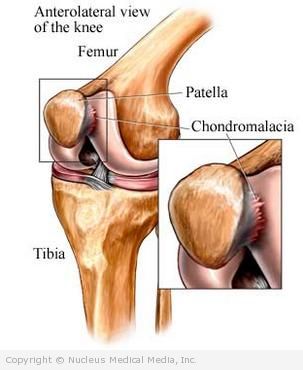Chondromalacia patella
Chondromalacia patella – Definition
Chondromalacia patella is a softening or wearing away of the articular cartilage on the undersurface of the kneecap (patella). Articular cartilage is a smooth substance that covers the femur (thighbone), the tibia (shinbone), and the patella. These structures form the knee joint. The articular cartilage cushions these three bones and allows them to move freely and easily where they meet in the knee. But, when the articular cartilage softens or wears away, pain and inflammation result.
Chondromalacia patella – Causes
Chondromalacia patella occurs when:
- The kneecap does not move properly in the groove in the knee where it meets the femur.
- There is a muscle imbalance of the quadriceps (thigh muscles), which control the patella.
This can occur due to:
- Congenital conditions — A person is born with a misalignment of the kneecap.
- Weak quadriceps — These muscles assist in proper movement of the knee joint. Weak quadriceps may allow the patella to move out of alignment.
- Muscle imbalance — This usually occurs when muscles on the outside of the thigh are stronger than muscles on the inside.
- Direct trauma — A fall or blow to the kneecap that damages the articular cartilage on the patella or the femur.
- Repeated trauma — The result of running, jumping, skiing, or other activities that put repeated pressure on the kneecap.
Chondromalacia patella – Risk Factors
A risk factor is something that increases your chances of getting a disease or condition. Risk factors for chondromalacia patella include:
- Age: adolescence and young adulthood
- Participation in activities that put repeated pressure on the patella-femoral joint:
- Running
- Skiing
- Cycling
- Soccer
- Knock-knee abnormality of the leg
Chondromalacia patella – Symptoms
The main symptom of chondromalacia patella is pain. The pain occurs beneath and on both sides of the kneecap. Other characteristics of the pain:
- The pain can be acute or chronic.
- A popping or cracking sound is often heard as the knee is flexed and extended.
- Symptoms usually increase and worsen slowly, over a year or more.
- Symptoms are usually most pronounced when:
- Climbing stairs
- Running
- Squatting
- Kneeling
- Doing any activity that puts pressure on the knee
- Pain and stiffness in the knee often occur when the patient is sitting with the knee bent for a long period of time (ie, a long car or plane ride).
Chondromalacia patella – Diagnosis
Your doctor will ask about your symptoms and medical history, as well as your exercise patterns, and perform a physical exam. Tests may include:
- An x-ray of the knee
- An MRI of the knee
- In rare cases, an arthroscopic exam of the knee
Chondromalacia patella – Treatment
Treatments for chondromalacia patella include:
Rest, Ice, Medication, and Bracing
The first line of treatment for chondromalacia patella is to:
- Decrease physical activity to allow the mechanical irritation and inflammation to subside.
- Ice the kneecap area for 15 minutes twice per day after physical activity and take anti-inflammatory medication (such as ibuprofen) to reduce inflammation and pain.
- Wear an elastic or neoprene brace on the knee to help keep the kneecap in proper alignment.
Exercise
Once pain and inflammation have subsided, exercise to strengthen the quadriceps (which control the knee) should begin. Exercise should be non-impact or non- or low- weight bearing, such as:
- Swimming
- Riding a stationary bicycle
- Using a cross-country ski machine
- Isometric or closed chain quadriceps strengthening exercises
Exercise should be done under the supervision of a physical therapist or athletic trainer.
Surgery
In most cases, surgery is not needed. But for younger patients who have continued pain, surgery may help. Surgical procedures include the following:
- Moving the quadriceps muscle insertion on the lower leg to improve alignment
- Releasing the lateral thigh muscles and tightening the medial muscles
- Smoothing over the undersurface of the patella (kneecap)
- Implanting cartilage taken from one’s own knee
Chondromalacia patella – Prevention
To help prevent chondromalacia patella, do the following:
- Do strengthening and stretching exercises for the:
- Quadriceps (thigh muscles)
- Calf muscles (muscles on the back of the lower leg)
- Hamstrings (muscles on the back of the thigh)
- Have footwear fitted with orthotic devices. These devices correct abnormal:
- Mechanics of the feet (particularly severe pronation)
- Musculoskeletal alignment in the legs and knees

